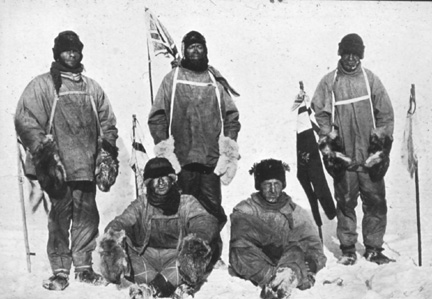by Hap Rocketto
I am in awe of the great adventurers who explored the high latitudes during the early years of the 1900s, the so called Heroic Age of Antarctic Exploration. These were hearty men who were as tough as woodpecker lips, inured to the freezing cold, capable of enduring incredible deprivations, and capable of writing about their adventures in both an erudite and dramatic style.
In the north it was men of the high caliber such as the Norwegian Fridtjof Nansen, who was more than just a polar explorer; he was also scientist, diplomat, humanitarian and Nobel laureate. On the other side of the coin were the two great polar antagonists, Robert Peary and Frederick Cook, who both questionably claimed primacy at the North Pole, yet were still positive contributors to the exploration of the far north land. Even Richard Byrd, whose claim to have reached the North Pole by air is in doubt-even though he most certainly did fly to the South Pole, is worthy of merit.
Ernest Shackleton, the luckiest of all Antarctic Explorers, was wildly popular because of his panache, daring, and charismatic public speaking.
Roald Amundsen, of Norway, would be the first to transit the Northwest Passage and also the first to reach the South Pole. With good cause many believe that, because of the reasonable doubt concerning Peary, Cook, and Byrd, when Amundsen and Umberto Nobile made the first crossing of the Arctic in the airship Norge, Amundsen and Oscar Wisting, who was part of Amundsen’s South Pole party, were the first persons to reach both geographical poles. There is even enough wiggle room to claim that Amundsen was also the first to the North Pole-presuming he was the furthest forward in the Norge when it crossed the top of the world.
Because of the circumstances of his death, and the beauty of his Victorian writing style, by far the most well known of the Antarctic explorers was Robert Falcon Scott. “Con” Scott lead two expeditions south. On the second he marched on foot with four companions 1500 of the 1600 mile round trip from his base to the South Pole. After arriving at the pole a few weeks after Amundsen, the discouraged party turned back toward home but eventfully succumbed to the privations of cold, thirst, hunger, scurvy, and exhaustion. Scott’s journals were recovered when a search party discovered the party’s remains the following spring. They became an instant publishing sensation and reserved for him a place in the pantheon of polar explorers. His heroism and writings were such that generations of British school children thought him first at the South Pole.
However this story revolves around Apsley George Benet Cherry-Garrard, a member of Scott’s second expedition, who, along with Dr, Edward Wilson and Lieutenant Henry Bowers, made what Garrard called in his account The Worst Journey in the World. It was a trip from the expedition’s base camp at Ross Island to Cape Crozier during the austral winter of 1911 in order to secure samples of Emperor penguin eggs. In nearly total darkness, with temperatures plunging to nearly −80 °F they walked 60 miles dragging nearly 800 pounds of supplies on two sledges. Upon reaching their goal they were trapped by a blizzard so strong it tore away their tent leaving them only their sleeping bags for shelter. They fortunately found the tent when the storm subsided after which they collected three eggs and trudged back to Cape Ross at a pace that was, at times, only a mile and a half a day.
In the end Cherry-Garrard philosophically summed up the whole terrible six week ordeal by simply saying that, “If you march your Winter Journeys you will have your reward, so long as all you want is a penguin’s egg.”
All this came to mind on New Year’s Day when a message arrived from Dan Holmes that stated, “We’re going for it. Come to Hopkinton tomorrow for 40 shots at 100 yards! There is a fair amount of snow but with the warm weather, the snow is soft which should make it easy to get the target frames in. We’ll be hanging one target and shooting 20 shots per bull. … Afterwards, we’ll get a few pizzas in the clubhouse.”
My brother Steve and I had been shooting in the gallery at least two times a week since the summer outdoor season closed with the Great Pumpkin Match in mid October when the message arrived. Most of our rounds down range have gone toward attempts to win the three winter leagues in which we participate. There is the Wednesday night shoulder to shoulder 40 shot four position Mohegan League, the weekly Friday 30 shot international Southwestern League, and the monthly English Match on the NRA/USA Shooting target Pickering Postal match.
The thought of escaping the bleak basement confines of the club for an outdoor match was overpowering. We weighed the four hours on the road, shooting in the January cold, sweeping away snow from the firing point, mucking through the snow drifts to place the frame and to hang the target, and locating all of our prone gear against getting to shoot 40 shots at 100 yards outside, being with a good number of our summer shooting cronies whom we had not seen in months, and getting to scarf down some pizza.
I told Steve I might have to think about it. To him the answer was clear as crystal, or, as he said paraphrasing Cherry-Garrard, “What is there to think about? If you march your Winter Journeys you will have your reward, so long as all you want is a rifle match.”


Another great article and a pleasure to read. However, yet another attempt by pronematchdotcom to pilfer one of our match group photos and pass it off as an illustration for something else. We had quite a bit of snow during the award ceremony last month and this is how it turned out.
Tommy Steadman